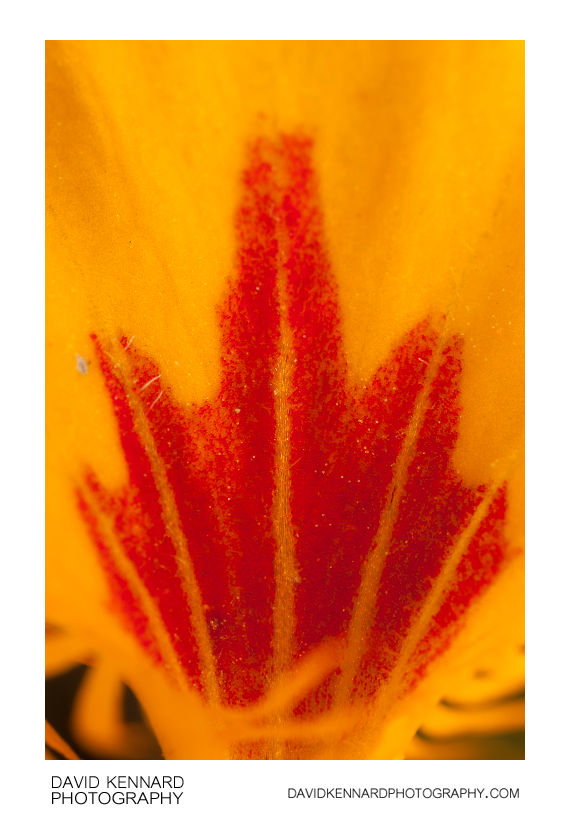Nasturtium 'Tom Thumb' yellow flower macro

Description
- Title:
- Nasturtium 'Tom Thumb' yellow flower macro
- Caption / Description:
-
Tropaeolum majus (Garden Nasturtium, Indian Cress or Monks Cress) is a flowering plant in the family Tropaeolaceae, originating in South America in the Andes from Bolivia north to Colombia. It is of cultivated, probably hybrid origin, with possible parent species including T. minus, T. moritzianum, T. peltophorum, and T. peregrinum.
It is a herbaceous annual plant with trailing stems growing to 1 m long or more. The leaves are large, nearly circular, 3-15 cm diameter, green to glaucous green above, paler below; they are peltate, with the 5-30 cm long petiole near the middle of the leaf, with several veins radiating to the smoothly rounded or slightly lobed margin. The flowers are 2.5–6 cm diameter, with five petals, eight stamens, and a 2.5–3 cm long nectar spur at the rear; they vary from yellow to orange to red, frilled and often darker at the base of the petals. The fruit is 2 cm broad, three-segmented, each segment with a single large seed 1–1.5 cm long.
It is widely cultivated, both as an ornamental plant and as a medicinal plant.
Garden Nasturtiums are grown for their flowers, and also because both their leaves and flowers are edible; they can be used in salads, imparting a delicately peppery taste. The seeds are also edible, and can be used as a caper substitute.
Description taken from Wikipedia: http://en.wikipedia.org/wiki/Tropaeolum_majus
- Tags / Keywords:
-
- Biota
- Life
- Vitae
- Eukaryota
- Plantae
- Plants
- Magnoliophyta
- Flowering Plants
- Angiosperms
- Magnoliopsida
- Dicotyledons
- Yellow
- Brassicales
- Red
- Tropaeolaceae
- Tropaeolum
- Nasturtium
- Tropaeolum majus
- Garden Nasturtium
- Indian Cress
- Monks Cress
- Tropaeolum majus 'Tom Thumb'
- Nasturtium 'Tom Thumb'
Admin
- Date Original Photo Taken:
- Original File Name:
- _MG_3941.CR2
- Event:
- Rating:
- ☆
- Date this image added/last updated on website:
- Original File Dimensions:
- 2659px x 3989px
- File Type:
- JPEG
- Color Mode:
- RGB
- Original Image Color Profile:
- Adobe RGB (1998)
Location
- Location Created:
-
- Sublocation:
- City:
- Market Harborough
- Province/State:
- Leicestershire
- Country:
- United Kingdom
- World Region:
- Europe
- Geo-location:
Rights
- Copyright Status:
- Copyrighted
- Licensing Status:
- Rights Managed
- Available for Editorial Use:
- Yes
- Available for Commercial Use:
- Yes
- Copyright Notice:
- © 2010 Dave Kennard
Camera Data
- Date Digital Resource was created:
- Shutter speed:
- 1⁄200 s
- Aperture:
- f/8
- Camera Model:
- Canon EOS 450D
- ISO:
- 100
- Exposure Compensation:
- 0
- Focal Length:
- 65mm
- Focal Length (35mm equiv.):
- Metering Mode:
- Multi-segment
- Flash:
- On, Fired
- Exposure Mode:
- Manual
- White Balance:
- Manual
- Light Source:
- Exposure Program:
- Manual
Additional shooting metadata
- Lens:
- Canon MP-E 65mm F2.8 1-5x Macro
- Filters used:
- Additional Optics used:
- Setup:
- Handheld
Canon MT-24EX Macro Twin Flash with home-made concave diffusers
Post Processing
- Image Modified:
- Software used:
-
- Adobe Camera RAW
- Post Processing:
-0.45 exposure compensation in ACR
Straightened in ACR
